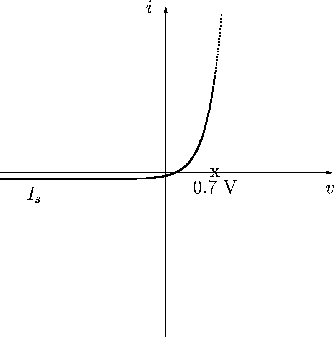




[ENGN2211 Home]
Nonlinear Model
The detailed behaviour of the diode can be explained in terms of semiconductor physics
which is beyond the scope of this course.
The nonlinear diode characteristic which can be obtained experimentally
is shown in Figure 72.
However, you should know about a key
equation from semiconductor physics:
![\begin{displaymath}i = I_s [ \exp ( \frac{q v}{kT} ) -1 ]
\end{displaymath}](diodeimg13.gif) |
(74) |
where
-
v and i are the diode voltage and current, as shown in Figure 67.
-
Is is the reverse-bias saturation current
(a common value might be 0.07 pA, although Is is proportional
to diode area).
-
kT/q = 26 mV at 300 K.
The nonlinear diode characteristic given by (74) is shown in Figure 72.
If v
increases towards around 0.7 V (silicon), then i increases very rapidly (exponentially).
The parameters may not be known exactly, and they may change with temperature,
etc., but a typical switch on voltage of 0.6-0.7 V is usually
found for Si (other types of diodes may be different,
e.g. LEDs might be 1.5 V and Schottky might be 0.3 V).
Figure 72:
Nonlinear diode characteristic.
 |





[ENGN2211 Home]
ANU Engineering - ENGN2211